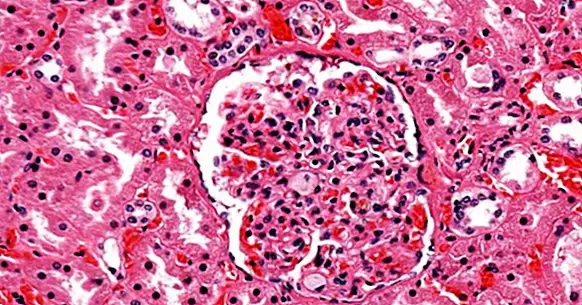Pick's disease: causes, symptoms and treatment
Dementias are a type of neurodegenerative disease in which different mental abilities are progressively lost, progressively deteriorating the person as a whole as the disease progresses. The best known of these diseases is Alzheimer's , although there are many others.
Within this group of disorders, another neurodegenerative disease that has characteristics very similar to those of Alzheimer's is known as Pick's disease . Let's see what their characteristics are.
- Related article: "Alzheimer's: causes, symptoms, treatment and prevention"
Pick's disease: main characteristics
Pick's disease is a neurodegenerative disorder which causes the progressive deterioration of the mental capacities of those who suffer it due to neuronal death. Thus, it provokes a frontotemporal type dementia, starting the cellular destruction in the frontal lobe to gradually expand to the temporal one.
This disease is a relatively common form of frontotemporal dementia, calculating that around 25% of them are due to Pick's disease. Symptoms usually begin between 40 and 50 years of age , and has the peculiarity that it is a disease that has no more prevalence as age increases (unlike Alzheimer's).
Like most other dementias, Pick's disease is a disease that causes a progressive and irreversible deterioration without there being periods of remission and that culminates with the death of the individual. It has a course of around 5 to 15 years between the onset of symptoms and the death or death of the subject.
symptom
The presentation of the symptoms of Pick's disease sometimes causes him to be confused with unusual forms of Alzheimer's, but It has characteristics that distinguish it from this and other dementias .
The main symptoms of dementia caused by this disease are the following.
1. Personality changes
One of the first symptoms to be perceived in Pick's disease is the presence of Sudden changes in the patient's personality . These changes usually refer to an increase in behavioral disinhibition, greater aggression and impulsivity, and even an increase in socialization. The opposite can also occur, presenting apathy and apathy.
2. Altered mood
Like the personality, the mood can also be altered already from the early stages of the disease. Emotional lability, irritability, nervousness or on the contrary emotional numbing can be seen frequently.
3. Executive functions
Taking into account that the alteration begins in the frontal, it is easy to associate this disease with the presence of alterations in the executive functions. Decision making, risk assessment, planning and maintenance or change of action are complicated. It is common to observe the existence of perseverance and even of obsessive characteristics. Especially marked is the lack of impulse control .
4. Socialization
It is also frequent that the social relations of the patient deteriorate. Although initially, in some cases, a approach to others by reducing the level of inhibition In the long run, social ties and skills deteriorate. It is also common for the weakening of self-control to cause them to exhibit hypersexuality, performing practices such as masturbation in public.
5. Memory
In its expansion by the frontal and the temporal, Pick's disease is gradually generating memory alterations both anterograde and retrograde. These alterations occur later compared with other dementias such as Alzheimer's, with which it is sometimes confused.
- Related article: "Types of memory: how memory stores the human brain?"
6. Language
Pick's disease usually causes alterations in the patient's language over time. It is common that speech, as well as literacy, slows down and loses fluency. Anomie, perseveration and repetition of words and echolalia are also frequent. The pragmatic use of language, both in its verbal and paraverbal aspects and its adaptation to specific norms and situations, also tend to present alterations.
Its causes
Pick's disease is a problem whose origin is unknown. However, it has been found that people suffering from Pick's disease present alterations in the genes coding for tau protein .
The tau protein appears in excess in the brain, within the complexes known as Pick bodies. These cells cause damage to the neurons in the frontal and temporal areas that culminate with a progressive atrophy of the cerebral lobes . The presence of abalonated neurons is also observed.
The fact that genetic mutations have been found in the genes that develop this protein indicates that this disease is influenced by genetics, and in fact it can be transmitted to offspring .
Treatment of Pick's disease
Dementia caused by Pick's disease does not have a treatment that can reverse its effects. In this way, Pick's disease does not properly have a curative treatment to this day . But in spite of this, it is possible to slow down the deterioration caused by the progression of the disease and help those affected to have a better quality of life.
At the psychological level, the use of Occupational therapy and neurostimulation in order to keep the patient mentally activated. It is also useful to use compensatory mechanisms with regard to skills that are being lost, such as the use of an agenda to control the things you must do and memory deficits have less effect on your daily life.
Psychoeducation, counseling and psychological support to the patient and his environment it is also essential, since it is facing a complicated situation in which the existence of information about what happens to the individual is essential to understand their situation.
At the pharmacological level, different psychotropic drugs such as antidepressants or even some antipsychotics can be used to control the symptoms.
Bibliographic references:
- Santos, J.L. ; García, L.I. ; Calderón, M.A. ; Sanz, L.J .; de los Ríos, P .; Left, S .; Román, P .; Hernangómez, L .; Navas, E .; Thief, A and Álvarez-Cienfuegos, L. (2012). Clinical psychology. CEDE Preparation Manual PIR, 02. CEDE. Madrid.



















